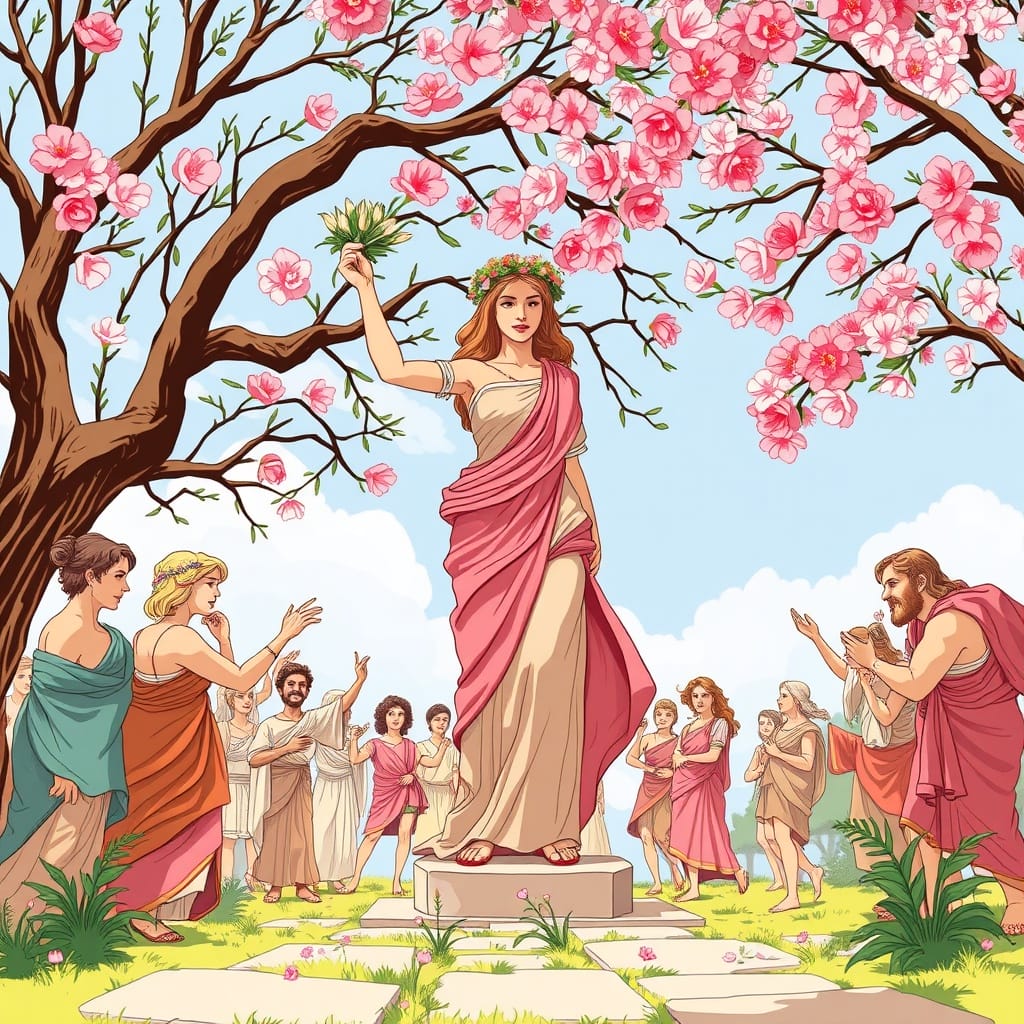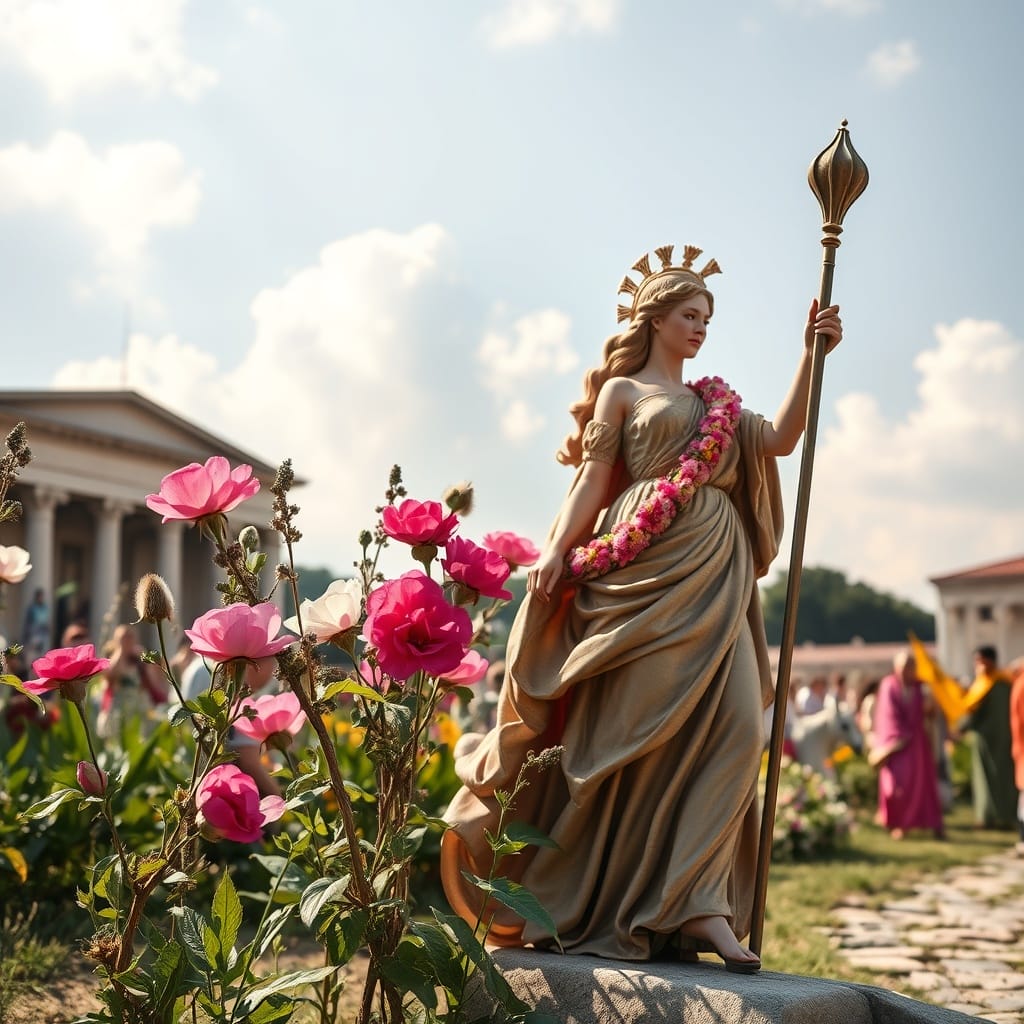The Floralia festival was a vibrant celebration in ancient Rome, held from April 28 to May 3, dedicated to Flora, the goddess of flowers and fertility. This festival marked the joyous arrival of spring, characterized by the blooming of flowers and the renewal of life. It played a crucial role in Roman culture, intertwining religious reverence with social festivities. Recognized for its games and theatrical performances, Floralia was not just a celebration of nature’s beauty but also a testament to the Romans’ deep connection with agricultural cycles.
Historical Background
The Floralia festival has its origins in ancient Rome, where it was established to honor Flora, the goddess of flowers and fertility. The festival began in 238 B.C. following a famine, when the Roman Senate consulted the Sibyl and initiated Floralia to appease Flora and ensure a bountiful harvest. Initially celebrated sporadically, it became a regular event by 173 B.C., coinciding with the founding of a shrine to Flora at the Circus Maximus on April 28.

| Year | Event |
|---|---|
| 240/238 B.C. | Dedication of the temple to Flora |
| 173 B.C. | Reinstatement as Ludi Florales |
| 69 B.C. | Cicero organizes Floralia |
| Renaissance Period | Speculations on Flora’s identity |
Over time, Floralia evolved from a religious observance into a public celebration filled with games, theatrical performances, and symbolic acts of fertility. Its rich history highlights the Romans’ deep connection to agricultural cycles and the celebration of spring’s renewal.
Significance of Flora
Flora, the Roman goddess of flowers and blossoming plants, plays a pivotal role in Roman mythology. Associated with spring and new growth, Flora is believed to have roots in Greek mythology as Chloris. She stands as a vital figure, embodying the renewal of life and fertility, essential for agricultural prosperity and the flourishing of nature.

“Flora was one of the fifteen deities with official cults during the Roman Republic, highlighting her importance in ensuring successful crops and vegetation.”
The symbolism of flowers and fertility in ancient Rome is deeply interwoven with Flora’s domain. Different plants, such as myrtle and laurel, were revered for their connections to love, beauty, and divine prophecy, reflecting the Romans’ appreciation for the natural world. These symbols extended beyond the aesthetic, representing vital cultural values and beliefs.
Flora’s festival, the Floralias, celebrated from April 28 to May 3, underscored her significance. It involved public worship and offerings, underscoring the principle of reciprocity in Roman religion. Through Flora, the Romans expressed their gratitude and sought blessings for bountiful harvests, reinforcing her pivotal role in their society.
Festive Traditions
Public Games
The Ludi Florales, or public games, were a cornerstone of Floralia celebrations in ancient Rome. Held from April 28 to May 3, these games were financed by curule aediles and included scenic performances, competitions, and unique activities such as the release of animals. These events served not only as entertainment but also as a means to honor Flora, symbolizing fertility and the protection of blossoms.

- Scenic performances featuring mimes and theatrical entertainment
- Public participation by actors, including prostitutes, in the celebrations
- Activities symbolizing fertility and abundance
Theatrical Performances
Central to the celebration of Floralia were theatrical performances, which highlighted the festival’s lively and uninhibited spirit. These performances included naked dancing, mock gladiatorial fights, and chariot races, underscoring the festival’s emphasis on life, sexuality, and the natural world.
- Participatory performances involving Rome’s prostitutes
- Vibrant activities reflecting the festival’s uninhibited atmosphere
Garland-Wearing and Street Dancing
The Floralia festival was also renowned for its traditions of garland-wearing and street dancing. Participants, adorned in colorful attire and flower wreaths, engaged in street dancing, reflecting the joyous spirit of spring and the Romans’ connection to nature.
- Wearing of multi-colored clothing and flower wreaths
- Street dancing fostering a sense of community and celebration
Connection to Nature
The Floralia festival serves as a vibrant testament to the Romans’ profound relationship with nature. Celebrated in late April to early May, it coincided with the onset of spring, a season emblematic of renewal and growth. By honoring Flora, the goddess of flowers, the festival underscored the Romans’ reverence for the earth’s fertility, which was crucial for their agricultural prosperity.

This celebration was intricately linked to the agricultural cycles of ancient Rome, emphasizing the planting and renewal phase of the calendar. Activities such as offerings to Flora and floral decorations highlighted the significance of fertility and growth during this critical sowing period. These rituals served as both a celebration and a plea for a fruitful planting season.
| Festival | Deity Honored | Season | Focus |
|---|---|---|---|
| Floralia | Flora | Spring | Renewal and Fertility |
| Saturnalia | Saturn | Winter | Harvest and Abundance |
| Lemuria | Spirits of the Dead | May | Life and Death Cycles |
| Consualia | Consus | August | Grain and Harvest |
Overall, Floralia exemplified the Romans’ integration of agricultural practices with religious beliefs, reinforcing their societal and cultural identity through nature’s cycles.
Seasonal Timing
The Floralia festival, occurring from late April to early May, was strategically positioned within the Roman calendar to coincide with the advent of spring. This timing was not arbitrary; rather, it was deeply rooted in the agricultural cycles of ancient Rome, marking a pivotal phase for planting and growth. The festival’s celebration of Flora, the goddess of flowers, symbolized the earth’s awakening and the renewal of life after the dormancy of winter.

Spring, a season synonymous with renewal, was vital for the Romans, as it heralded the opportunity for a productive agricultural season. The symbolism of renewal and rebirth permeated the festivities, with rituals and activities designed to promote fertility and ensure a bountiful harvest. Floral decorations and offerings to Flora underscored the community’s gratitude for nature’s abundance and their hope for divine favor in the upcoming planting season.
Thus, Floralia was more than just a celebration; it was a reaffirmation of the Romans’ connection to the natural world and their reliance on its cycles for sustenance and prosperity. This festival exemplified the harmonious integration of religious observance and agricultural practice, reinforcing the Romans’ profound respect for nature’s rhythms.
Cultural Impact
The Floralia festival played a pivotal role in shaping Roman social structures by fostering community cohesion and shared cultural identity. During the celebrations, societal norms were momentarily relaxed, allowing individuals from various social strata to mingle freely. This temporary suspension of class distinctions is reminiscent of the Saturnalia festival’s reversal of social roles. Such events provided a unique opportunity for communal interaction and solidarity.

Floralia’s vibrant festivities, including public games and theatrical performances, facilitated a sense of unity among participants. The shared experience of honoring Flora, the goddess of flowers, through rituals and garland-wearing dances, strengthened bonds within the community. A historical account by the Roman poet Ovid illustrates how the joyous atmosphere of Floralia brought together citizens in a collective expression of gratitude for nature’s bounty.
Moreover, the festival’s emphasis on the arrival of spring and renewal reinforced the Romans’ connection to the agricultural cycle, uniting them in their reliance on nature for sustenance. Through these communal celebrations, Floralia not only highlighted the Romans’ reverence for the natural world but also cultivated a lasting sense of community and cultural continuity.
Floralia in Art and Literature
The Floralia festival left a notable imprint on Roman art and literature, reflecting its cultural significance. Artists often depicted scenes from Floralia in vibrant frescoes and mosaics, capturing the essence of its lively celebrations. One notable example includes the frescoes from Pompeii, which illustrate participants adorned in floral garlands, dancing and reveling in the seasonal joy of spring. These artworks not only highlight the aesthetic beauty of the festival but also underscore the Romans’ profound appreciation for nature.

In literature, the festival is vividly portrayed in the works of Roman poets. Ovid, in his “Fasti,” provides a detailed account of Floralia, celebrating Flora as the embodiment of spring’s renewal and fertility. His verses eloquently describe the abundance of flowers and the jubilant atmosphere that characterized the festival. Such literary references not only immortalize Floralia’s importance but also offer insights into how Romans intertwined their cultural practices with their reverence for the natural world.
Through these artistic and literary portrayals, Floralia is immortalized as a testament to the Romans’ enduring connection with nature and their cultural identity.
Modern Celebrations
The Floralia festival, once an ancient Roman tribute to spring and fertility, has experienced a vibrant revival in modern times. Cities, particularly in Italy, now host annual events that mirror the traditional festivities, featuring parades, floral displays, and performances. These contemporary adaptations maintain the spirit of renewal and rebirth, akin to the original celebrations.

Modern interpretations also incorporate art and music, drawing inspiration from nature’s themes to appeal to diverse audiences. The emphasis on sustainability aligns with current ecological priorities, promoting local flora and environmentally responsible practices.
Parallels can be drawn between Floralia and other contemporary spring festivals. For example, the Cherry Blossom Festival in Japan and the Hindu festival of Holi, both celebrate nature’s beauty and the season’s renewal. Similarly, May Day and Ostara share Floralia’s themes of fertility and rebirth. Through these festivals, the enduring human connection to nature and celebration remains strong, much like the ancient Floralia.

Conclusion
The Floralia festival stands as a testament to the Roman celebration of spring and fertility, reflecting the profound connection between humans and nature. Its historical significance is marked by lively theatrical performances, public games, and symbolic floral rituals.
Floralia’s impact on Roman culture is evident in its role in fostering community bonds and celebrating the cycles of nature. Today, its legacy endures through modern adaptations that blend traditional elements with contemporary values, enriching cultural landscapes worldwide and underscoring its timeless themes of renewal and rebirth.

Floralia FAQ
What is Floralia?
Floralia is an ancient Roman festival held in honor of Flora, the goddess of flowers and fertility. Celebrated from April 28 to May 3, it marked the arrival of spring through public games, theatrical performances, and floral adornments.
How is Floralia celebrated today?
Today, Floralia has seen a modern revival with cultural festivals in cities, particularly in Italy. These events feature parades, floral displays, art installations, and music performances, integrating traditional elements with contemporary interpretations.
What are some misconceptions about Floralia?
A common misconception is that Floralia was solely a religious event. While it honored a deity, it was also a time for community bonding and celebration of nature’s cycles, reflecting broader societal values beyond religious devotion.
Is Floralia similar to other festivals?
Yes, Floralia shares themes with modern festivals like Holi, the Cherry Blossom Festival, and May Day. These festivals also celebrate spring, fertility, and nature, illustrating enduring human connections to these themes.

